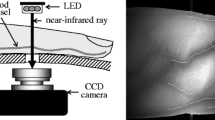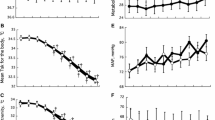Abstract
Recent work in our laboratory has shown that vasodilation produced during temperature biofeedback training is mediated through a nonneural, beta-adrenergic mechanism. Here we sought to determine if the effects of feedback training for vasoconstriction are produced through a neural or nonneural pathway and whether other measures of physiological activity are correlated with these changes. Nine normal subjects received temperature feedback vasoconstriction training in which feedback was delivered only during periods of successful performance. In a subsequent session, the nerves to one finger were blocked with a local anesthetic while finger blood flow was recorded from this and other fingers. Vasoconstriction occurred during feedback in the intact fingers but not in the nerve-blocked finger and was accompanied by increased skin conductance and heart rate. These data demonstrate that temperature feedback vasoconstriction training is mediated through an efferent, sympathetic nervous pathway. In contrast, temperature feedback vasodilation training is mediated through a nonneural, beta-adrenergic mechanism.
Similar content being viewed by others
References
Cohen, R., & Coffman, J. (1981). Beta-adrenergic vasodilating mechanism in the finger.Circulation Research, 49 1196–1201.
Fetcher, E., Hall, J., & Shaub, H. (1949). The skin temperature of an extremity as a measure of its blood flow.Science, 110 422–423.
Freedman, R., Ianni, P., & Wenig, P. (1983). Behavioral treatment of Raynaud's disease.Journal of Consulting and Clinical Psychology, 51 539–549.
Freedman, R., Sabharwal, S., Ianni, P., Desai, N., Wenig, P., & Mayes, M. (1988). Non-neural β-adrenergic vasodilating mechanism in temperature biofeedback.Psychosomatic Medicine, 50 394–401.
Jamieson, C., Ludbrook, J., & Wilson, A. (1971). The response of hand blood flow to distant ice application.Australian Journal of Experimental Biology and Medical Science, 49 145–155.
Keefe, F., & Gardner, E. (1979). Learned control of skin temperature: Effects of short and long-term biofeedback training.Behavior Therapy, 10 202–210.
Shepherd, J. T. (1963).Physiology of the circulation in human limbs in health and disease. Philadelphia: Saunders.
Surwit, R., Shapiro, D., & Feld, J. (1976). Digital temperature autoregulation and associated cardiovascular changes.Psychophysiology, 13 242–248.
Taub, E. (1977). Self-regulation of human tissue temperature. In G. E. Schwartz & J. Beatty (Eds.),Biofeedback: Theory and research (pp. 265–300). New York: Academic Press.
Wallin, B., Delius, W., & Hagbarth, K. (1973). Comparison of sympathetic nerve activity in normotensive and hypertensive subjects.Circulation Research, 23 9–21.
Author information
Authors and Affiliations
Additional information
This work was supported by research grant HL-30604 from the National Heart, Lung, and Blood Institute.
Rights and permissions
About this article
Cite this article
Freedman, R.R., Morris, M., Norton, D.A.M. et al. Physiological mechanism of digital vasoconstriction training. Biofeedback and Self-Regulation 13, 299–305 (1988). https://doi.org/10.1007/BF00999086
Issue Date:
DOI: https://doi.org/10.1007/BF00999086




